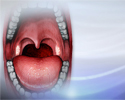Drooling
Salivation; Excessive saliva; Too much saliva; Sialorrhea
Drooling is saliva flowing outside the mouth.
Considerations
Drooling is generally caused by:
- Problems keeping saliva in the mouth
- Problems with swallowing
- Too much saliva production
Some people with drooling problems are at increased risk of breathing saliva, food, or fluids into the lungs. This may cause harm if there is a problem with the body's normal reflexes (such as gagging and coughing).
Causes
Some drooling in infants and toddlers is normal. It may occur with teething. Drooling in infants and young children may get worse with colds and allergies.
Drooling may happen if your body makes too much saliva. Infections can cause this, including:
- Mononucleosis
- Peritonsillar abscess
- Strep throat
- Sinus infections
- Tonsillitis
Other conditions that can cause too much saliva are:
- Allergies
- Heartburn or GERD (gastroesophageal reflux disease)
- Poisoning (especially by pesticides)
- Pregnancy (may be due to pregnancy side effects, such as nausea or reflux)
- Reaction to snake or insect venom
- Swollen adenoids
- Use of certain medicines
Drooling may also be caused by nervous system disorders that make it hard to swallow. Examples are:
- Amyotrophic lateral sclerosis, or ALS
- Autism
- Cerebral palsy (CP)
- Down syndrome
- Multiple sclerosis
- Parkinson disease
- Stroke
Home Care
Popsicles or other cold objects (such as frozen bagels) may be helpful for young children who are drooling while teething. Take care to avoid choking when a child uses any of these objects.
For those with chronic drooling:
- Caregivers may try reminding the person to keep their lips closed and chin up.
- Limit sugary foods, because they may increase the amount of saliva.
- Watch for skin breakdown around the lips and on the chin.
When to Contact a Medical Professional
Contact your health care provider if:
- The cause of the drooling has not been diagnosed.
- There is concern about gagging or choking.
- A child has a fever, difficulty breathing, or holds their head in a strange position.
What to Expect at Your Office Visit
Your provider will do a physical exam and ask questions about your symptoms and medical history.
Testing depends on a person's overall health and other symptoms.
A speech therapist can determine if the drooling increases the risk of breathing in food or fluids into the lungs. This is called aspiration. A speech therapist may provide information about:
- How to hold your head
- Lip and mouth exercises
- How to encourage you to swallow more often
Drooling caused by nervous system problems can often be managed with drugs that reduce saliva production. Different drops, patches, pills or liquid medicines may be tried.
If you have severe drooling, the provider may recommend:
- Botulinum toxin (Botox) shots
- Radiation to the salivary glands
- Surgery to remove the salivary glands
References
Nicholson AM, Hess JM. Esophagus, stomach, and duodenum. In: Walls RM, ed. Rosen's Emergency Medicine: Concepts and Clinical Practice. 10th ed. Philadelphia, PA: Elsevier; 2023:chap 75.
Ostrem JL, Okun MS. Parkinsonism. In: Goldman L, Cooney KA, eds. Goldman-Cecil Medicine. 27th ed. Philadelphia, PA: Elsevier; 2024:chap 378.
Slavotinek AM. Dysmorphology. In: Kliegman RM, St. Geme JW, Blum NJ, Shah SS, Tasker RC, Wilson KM, eds. Nelson Textbook of Pediatrics. 21st ed. Philadelphia, PA: Elsevier; 2020:chap 128.
Weiss AK, Balamuth FB. Triage of the acutely ill child. In: Kliegman RM, St. Geme JW, Blum NJ, Shah SS, Tasker RC, Wilson KM, eds. Nelson Textbook of Pediatrics. 21st ed. Philadelphia, PA: Elsevier; 2020:chap 80.
Review Date: 10/13/2023
Reviewed By: Linda J. Vorvick, MD, Clinical Professor, Department of Family Medicine, UW Medicine, School of Medicine, University of Washington, Seattle, WA. Also reviewed by David C. Dugdale, MD, Medical Director, Brenda Conaway, Editorial Director, and the A.D.A.M. Editorial team.






